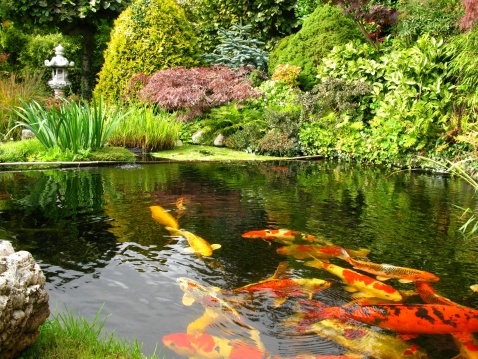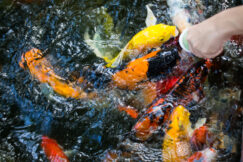Are you looking for a way to save your beloved koi fish? Don’t worry; you’re not alone!
This blog post will cover the steps to give your koi fish the best chance of survival. We’ll also provide tips and tricks that can help improve the overall health of your koi fish.
Uncover the Cause of Koi Stress
When a Koi fish appears stressed or sick, it’s important to uncover the cause of the problem so that you can address it quickly and effectively.
Poor water quality, temperature fluctuations, overcrowding, inadequate oxygen levels, parasites, poor diet, or a combination of these factors usually cause stress in Koi.
To uncover the cause of the stress, it’s best to start with the basics, such as water quality and temperature, then move on to more complex issues like parasites and diet.
Once you have identified the cause of the stress for your Koi, you can improve the situation and restore your fish’s health.
Check Your Water Quality
Maintaining healthy water quality for all fish, especially for koi, is essential. Poor water quality can lead to various issues, such as disease, parasites, and stress.
Regularly test your pond’s water for ammonia, nitrite, nitrate levels, pH, and other parameters. The ideal range for ammonia and nitrite should be 0 ppm, and nitrates should be below 20 ppm. The ideal pH range is 6.5-8.5. If levels are outside the optimal range, you may need to adjust with a water conditioner or other product.
Also, ensure your pond is not overstocked and you are not overfeeding your koi. Make regular water changes and check your filtration system to ensure it works properly and keeps the water clean.
Create a Healthy Environment for Koi Fish
Creating a healthy environment for your koi fish is essential for their survival. This includes providing them with clean, high-quality water and a balanced diet.
Additionally, it is important to ensure that the pond temperature and oxygen level are within the ideal range. You should also ensure enough space, shade, and hiding places for the fish.
An important part of creating a healthy environment is introducing beneficial bacteria to the pond, which will help to break down waste and maintain good water quality. It is also important to inspect the fish for parasites and treat them appropriately if found.
Lastly, practice quarantine protocols when introducing new fish into the pond. By creating a healthy environment for your koi fish, you can ensure they remain healthy and happy.

Monitor Temperature and Oxygen Levels
Maintaining the correct temperature and oxygen levels in the water is essential for the health of your koi fish.
Temperature changes can be very stressful for them, so you should aim to keep the water temperature stable between 60 and 70 degrees Fahrenheit. To monitor this, you should use a digital thermometer to check the water temperature regularly.
Oxygen levels are also important for your koi health, so check them using an oxygen meter. The ideal oxygen level for your koi is between 7.0 and 9.0mg/L. If the oxygen level is too low, you should consider introducing plants to the pond or adding an aerator to increase oxygen levels.
Introduce Beneficial Bacteria to the Pond
One of the most important things to remember when attempting to save a dying koi fish is introducing beneficial bacteria to the pond.
Beneficial bacteria help to break down waste and toxins, making the water cleaner and healthier for fish.
This can be done with a product specifically designed for this purpose or by adding a small amount of aquarium gravel to the water. Gravel contains helpful bacteria that will help to break down waste and create a healthier environment for the fish.
Additionally, introducing beneficial bacteria to the pond will help to restore the balance of healthy bacteria in the water, which can help to prevent disease and illness.
Inspect for Parasites and Treat them Appropriately
One of the most important things to look out for when assessing your koi’s health is parasites. Parasites can cause various issues, such as skin lesions, loss of appetite, and in some cases, death.
It’s important to inspect your koi regularly for any signs of parasites, and if you find any, treat them immediately. Many products are available on the market designed specifically to combat parasites, so be sure to research the best option for your koi before moving forward.
Additionally, it’s important to note that even after treating the parasites, you should monitor your koi closely to ensure they’ve fully recovered.
Improve Diet with High-Quality Food
One of the most important things to consider when trying to save a dying koi fish is its diet. Quality food is essential for the health of any fish, and koi are no exception.
The best koi food has a balanced ratio of protein, fat, fiber, vitamins, minerals, and essential fatty acids. Look for food specifically formulated for koi and contains natural ingredients like fish meal, kelp meal, shrimp meal, and wheat germ.
It’s also important to avoid foods with artificial colors or preservatives as these can harm koi. Feed your koi two to three times a day, but only as much as they can consume in a few minutes. This will ensure that they get all the nutrients they need without overfeeding.
Increase Filtration Capacity if Necessary
One of the most important steps in saving a dying koi fish is to increase the filtration capacity of the pond.
A good filtration system helps to maintain water quality, remove debris from the water, and reduce the build-up of toxins. It also helps to oxygenate the water, which is especially important for koi struggling to breathe.
If your current filter is not adequate for the size of your pond, consider investing in a larger one to ensure adequate water circulation and filtration. Have your filter professionally serviced and cleaned regularly to keep it working efficiently.
Provide Shade in Hot Weather Conditions
Hot weather can cause koi fish to become stressed and suffer from oxygen deprivation, so providing shade for your pond is essential.
You can create shade using natural elements, such as trees and shrubs, or a canopy or sunshade specifically designed for ponds.
Be sure to monitor the water temperature and watch for signs of stress in the fish, such as gasping at the surface or listlessness.
If your pond doesn’t have access to natural shade, you may need to take extra steps to keep your koi cool in hot weather.
Practice Quarantine Protocols for New Fish
When introducing new fish to the pond, it is important to practice quarantine protocols. This helps to reduce the risk of spreading illnesses and other infections to existing stock.
Quarantine periods can last anywhere from a few weeks to a few months, depending on the fish species and the infection’s severity. During this time, it is important to maintain optimal water quality and provide a healthy diet.
Additionally, it is important to inspect the new fish for any signs of disease or parasitic infestations and treat them accordingly. This will help ensure the health of your existing fish population and any new additions.
Utilize Antibiotics or Medications as Needed
Antibiotics or medications may be necessary to restore their health when treating sick koi. If the cause of their illness is bacterial, antibiotics can be used to eliminate the infection.
If parasites are the culprit, medications such as formalin or malachite green can help treat the condition.
It is important to always consult a veterinarian before administering any medication, as they can provide the correct dosage and recommendations appropriate for your specific situation.
Make sure to follow all instructions carefully, as improper use of medications can do more harm than good.
Perform Regular Maintenance on the Pond
Regular maintenance of your pond is essential for keeping your koi healthy. This includes cleaning out any excess debris in the pond, such as dead leaves or fish waste.
You should also check to ensure the water is not too murky, as this can cause health problems for your koi. Additionally, if you have a filter system, ensure it runs efficiently and that all filters are clean.
Finally, you should check to ensure the water temperature is appropriate for your koi’s species. These steps will help keep your pond clean and your koi healthy.
Seek Veterinary Assistance when Necessary
In some cases, you may find it necessary to seek the advice of a veterinarian or koi specialist. While it is possible to save a dying koi fish, the process can be complicated, and it is best to consult with an expert if you are uncertain about how to proceed.
A vet can provide valuable insight on diagnosing the underlying cause of your fish’s distress and recommend the best course of action. In some cases, medications and treatments might be necessary, which only a qualified veterinarian can provide.
It is important to remember that a successful recovery from any serious health issue requires patience, diligence, and proper care. Following these steps can help your koi fish have a long and healthy life in your pond.
Conclusion
Caring for koi fish is no easy task, but with some knowledge and dedication, you can save a dying fish.
Identify the cause of the stress, check water quality, create a healthy environment, monitor temperature, and oxygen levels, introduce beneficial bacteria to the pond, inspect for parasites and treat appropriately, improve diet with high-quality food, increase filtration capacity if necessary, provide shade in hot weather conditions, practice quarantine protocols for new fish, utilize antibiotics or medications as needed, and perform regular maintenance on the pond.
If all else fails, don’t hesitate to seek veterinary assistance. Keeping these tips in mind and tending to your koi fish with love and care will ensure they remain healthy and happy for many years.




